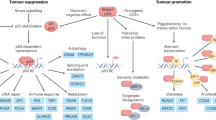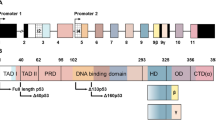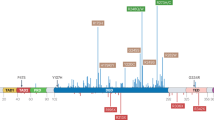Abstract
p53 alterations at the DNA, mRNA and protein levels were studied in tumour metastases sampled from 30 patients with malignant melanoma. Paraffin-embedded sections from these and an additional 12 patients were examined for the presence of p53 protein. TP53 gene aberrations were found in 7 of 30 (23%) of the patients, six of which showed loss of heterozygosity (LOH). Point mutations were detected in only two cases, one of which had LOH whereas the other was non-informative. Increased levels of p53 mRNA were present in only one tumour with, but in six cases without, detectable DNA abnormalities. Four of the latter and six tumours with normal transcript levels had immunohistochemically detectable levels of p53 protein. In 25 cases in which corresponding primary and metastatic lesions could be compared, closely similar immunoreactivity patterns were observed. Increased expression of the MDM2 gene was found in only one tumour in parallel with overexpression of p53. Altogether, the data indicate that inactivation of the p53 regulatory pathway is not of major significance in the tumorigenesis of malignant melanoma. However, a significant association was found between p53 immunoreactivity and the relapse-free period in patients with superficial spreading melanoma. That increased protein expression was predominantly found in tumours without DNA alterations might suggest a role for the wild-type p53 protein in restricting malignant cell proliferation in these cases.
This is a preview of subscription content, access via your institution
Access options
Subscribe to this journal
Receive 24 print issues and online access
$259.00 per year
only $10.79 per issue
Buy this article
- Purchase on SpringerLink
- Instant access to full article PDF
Prices may be subject to local taxes which are calculated during checkout
Similar content being viewed by others
Author information
Authors and Affiliations
Rights and permissions
About this article
Cite this article
Flørenes, V., Øyjord, T., Holm, R. et al. TP53 allele loss, mutations and expression in malignant melanoma. Br J Cancer 69, 253–259 (1994). https://doi.org/10.1038/bjc.1994.48
Issue date:
DOI: https://doi.org/10.1038/bjc.1994.48
This article is cited by
-
G-quadruplexes: a promising target for cancer therapy
Molecular Cancer (2021)
-
Evaluation of potential interactions between the metastasis-associated protein S100A4 and the tumor suppressor protein p53
Amino Acids (2011)
-
Telomere erosion triggers growth arrest but not cell death in human cancer cells retaining wild-type p53: implications for antitelomerase therapy
Oncogene (2004)
-
p53 mutations in human cutaneous melanoma correlate with sun exposure but are not always involved in melanomagenesis
British Journal of Cancer (1999)
-
In squamous cell carcinoma of the vulva, overexpression of p53 is a late event and neither p53 nor mdm2 expression is a useful marker to predict lymph node metastases
British Journal of Cancer (1999)



